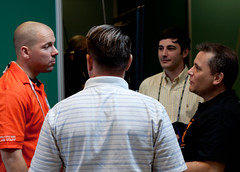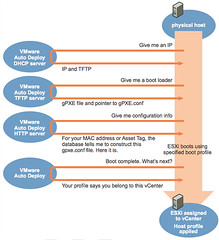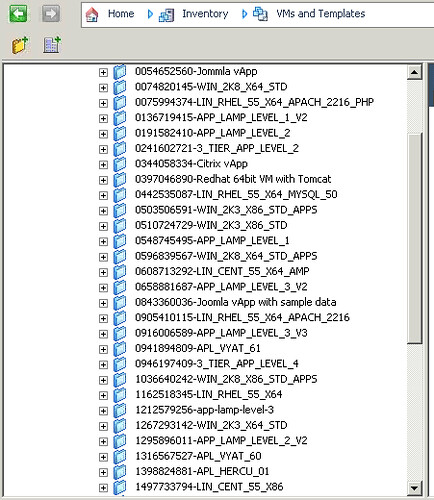On a couple of occasions in the past few weeks I’ve had to generate log bundles for both and VMware View Connection Brokers and View Composer. VMware provides a simple script, which collects all of the relevant logs for you and creates a tidy zip file for you to send off to VMware Support.
Great! Unless your C drives is running low on space…..
The log bundles created automatically get placed onto the desktop of the user running the script (C:\Documents and Settings\<current user>\Desktop). These log bundles vary in size and can be up to 1GB each. So if your C drive is almost full before hand, it soon would be completely full.
With the help of Ian Gibbs from Virtual Clarity we have been able to find a way of redirecting these logs to a destination of our choice.
Read the rest of this entry »
 Hi guys, just a quick post to remind you that the next vBeers will be help this Thursday, December 2nd. This month it's a bit of a joint vBeers/StorageBeers so there should be another great turnout. And as it's the festive season feel free to wear your favorite Christmas hat. 🙂
Hi guys, just a quick post to remind you that the next vBeers will be help this Thursday, December 2nd. This month it's a bit of a joint vBeers/StorageBeers so there should be another great turnout. And as it's the festive season feel free to wear your favorite Christmas hat. 🙂
When & Where
The London vBeers is held on the first Thursday of every month starting at 6pm in ‘The Cittie of Yorke’ pub which is placed centrally to both London’s West End and The City. This venue serves a fine of selection of English beers along with soft drinks and bar snacks.
- Location: The ‘Cittie of Yorke’, London
- Address: 22 High Holborn, London, WC1V 6BS
- Nearest Tube: Chancery Lane
- Time: 6:00pm
- Ye Olde Map: MAP
What are vBeers? Read More
 I've just returned from a week away at VMworld Europe. I'm still a little blurry eyed from the late nights, early mornings and information overload. Although I am suffering a little now, I have to say it was well worth it.
I've just returned from a week away at VMworld Europe. I'm still a little blurry eyed from the late nights, early mornings and information overload. Although I am suffering a little now, I have to say it was well worth it.
This was my first ever VMWorld and was fortunate to get invited to attend as a blogger by HP. So first of all, I'd like to say thanks to HP. Secondly, I've you've never been before; MAKE SURE YOU GO NEXT YEAR!!!
Read the rest of this entry »

The SLOG has been voted 11th in the world out of all of the virtualization blogs.
http://vsphere-land.com/news/top-vmware-blogger-results.html
Thank you to all that voted for both my Blog and all of the other Blogs out there.

This morning received an email linking me to a great document called; More fun with vSphere Alarms
It's written by a guy from VMware called Horst Mundt who is from Germany. Get it, Read it. It's really really useful. I've always wanted to be able to create my own custom alarm's in vCenter but I've never really fully had the capabilities to do it. Now with the release of vSphere 4.1 I can.
Read the rest of this entry »
 Since starting at VMware I've spoken to a lot of people who've told me they have problems finding good VMware best practice documentation for HDS Storage. I was fortunate enough to attend the HDS Bloggers Day back in April, at which I met some great people and made some good contacts. I've been in touch with them and spoken to them about my colleagues views on the lack of good HDS documentation relating to vSphere and they pointed me to the following website:
Since starting at VMware I've spoken to a lot of people who've told me they have problems finding good VMware best practice documentation for HDS Storage. I was fortunate enough to attend the HDS Bloggers Day back in April, at which I met some great people and made some good contacts. I've been in touch with them and spoken to them about my colleagues views on the lack of good HDS documentation relating to vSphere and they pointed me to the following website:
http://www.hds.com/go/oneforall/thankyou.html
http://www.hds.com/solutions/applications/application-vmware.html
The site contains many PDF's and video's including:
So if you're using HDS Storage, it might be worth giving it a look.
If you can't find something you need on there, contact me via the Contact page and I'll get in touch with Hitachi for you.
Update: I've managed to get another couple of links for you:
Over the past few days I've been looking into deployment tools to help me deploy a large amount of ESXi Host's in a short space of time. One of the tools I've been looking at is VMware Auto Deploy

VMware Auto Deploy
The auto deploy application which comes as an OVT template is basically just a jumped-up vMA, with the added extra's of DHCP, TFTP, HTTP servers and a deploy-cmd CLi and Database.
Here is a brief overview of how VMware Auto Deploy works once configured:
- PXE boot the target server
- ESXi is installed onto the target server from the auto deploy app
- The ESXi host will then be added into your vCenter
- The ESXi host will then have a Host Profile applied to it.
This makes life pretty easy.
What I didn't know and it didn't mention on the labs site was that the ESXi install was Stateless. The ESXi install is only held in memory. So if you reboot the server you'd see a "No Operating System Found" message.
Before VMware Auto Deploy, I hadn't ever given Stateless ESXi a second thought. The configuration of a host once ESXi was installed was a lot more detailed than the initial install itself and took time to complete. Now with the use of Host Profiles we are able to Install and Configure an ESXi host within a matter of minutes and 100% automatically. At this rate I'll be doing myself out of a job! However, I also believe it's the way most large deployments will head in the not so distant future. We are beginning to see an increase in the amount of diskless servers/blades coming onto the market, which is ushering us down the route of using Stateless installs.
I'm not going to go into the in's and out's of the application configuration as it's all available in the VMware Auto Deploy Administrator's Guide. It's very simple
 I saw this little discussion on an internal mailing list a week or so ago and I've decided to post it too The SLOG – 1. So I don't forget it, 2. I'm sure many of you will at some point use Jumbo frames in the future on your vSphere environments.
I saw this little discussion on an internal mailing list a week or so ago and I've decided to post it too The SLOG – 1. So I don't forget it, 2. I'm sure many of you will at some point use Jumbo frames in the future on your vSphere environments.
Question: "Assuming that I enable jumbo frames, is there a way on in the VM to determine is jumbo frames are truly supported end-to-end?"
Answer:
In your VM, ping your destination with a large message and specify don’t fragment.
- Linux VMs: ping –M do –s 8000 <ip address or destination>
- Windows VMs: ping –f –l 8000 <ip address or destination>
- ESX(i): vmkping –d –s 8000 <ip address or destination>

Another year has passed….Where the hell did that go? Well you may or may not have heard that the vSphere-Land.com Top Bloggers in VMware and Virtualization Award nominations have been released and voting has commenced.
Once again I'm both pleased and honoured to have my Blog on the shortlist amongst some of the worlds top Virtualization Bloggers.
So if your a regular reader of the various Virtualization Blogs, it would be great if you could vote for your favourites.
For more information visit www.vsphere-land.com

Trying to admin your vCloud using the vSphere Client might become a little confusing.

 I've just returned from a week away at VMworld Europe. I'm still a little blurry eyed from the late nights, early mornings and information overload. Although I am suffering a little now, I have to say it was well worth it.
I've just returned from a week away at VMworld Europe. I'm still a little blurry eyed from the late nights, early mornings and information overload. Although I am suffering a little now, I have to say it was well worth it.






